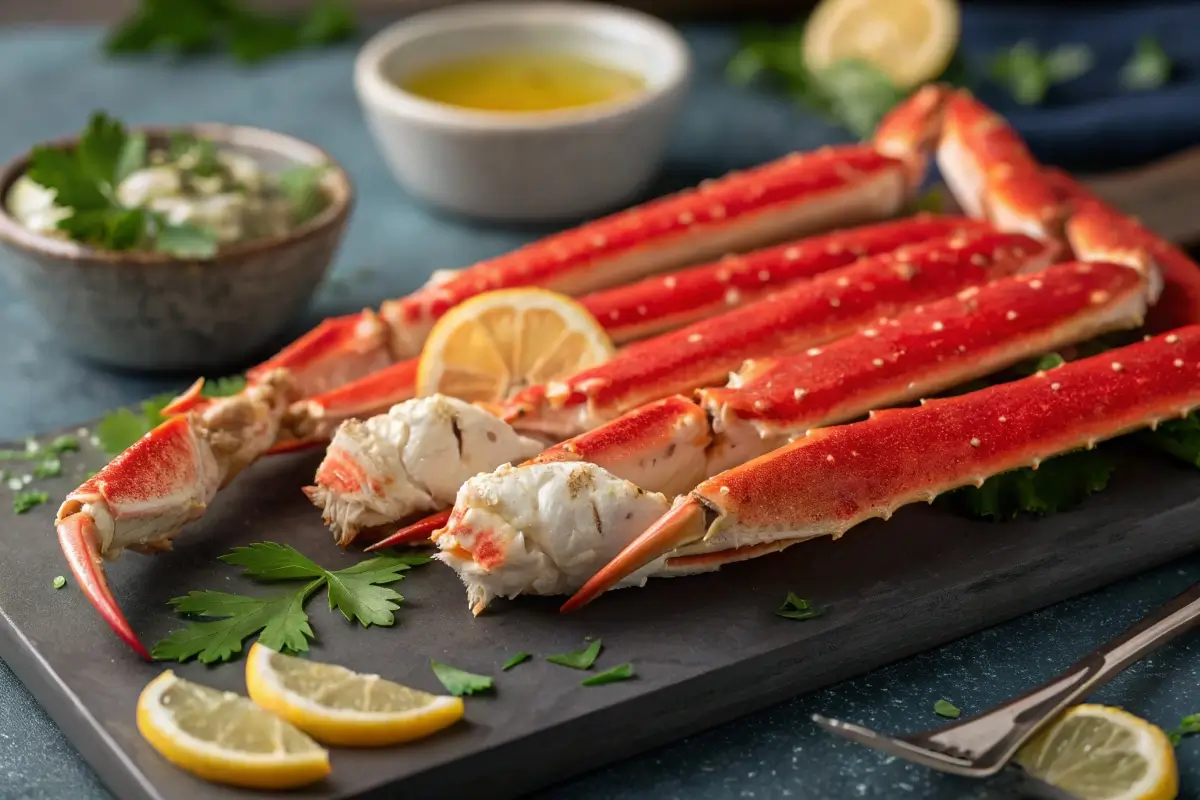A Classic Snow Crab Legs Recipe with Garlic Butter Sauce
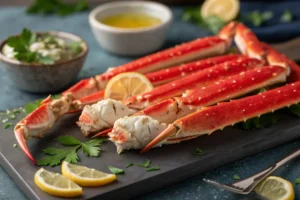
This classic recipe combines the sweet taste of snow crab legs with a rich and savory garlic butter sauce. It’s perfect for a special occasion or a simple weeknight treat
Type: Main Course
Cuisine: American
Keywords: Snow Crab Legs
Recipe Yield: 4 servings
Calories: 185.5 (crab) + 200 (butter) + 5 (garlic) + 4 (lemon juice) = Approximately 394.5 calories per serving
Preparation Time: PT10M
Cooking Time: PT13M
Total Time: PT23M
Recipe Ingredients:
- 2 lbs snow crab legs, thawed or frozen
- ½ cup (1 stick) unsalted butter
- 4 cloves garlic, minced
- 2 tablespoons lemon juice, fresh
- 1 tablespoon fresh parsley, chopped
- ½ teaspoon salt
- ¼ teaspoon black pepper
- Lemon wedges, for serving
Recipe Instructions: Prepare the Snow Crab Legs: Using your preferred method, steam, boil, or bake the snow crab legs according to the methods described above. Melt the butter in a small saucepan over low heat. Add the minced garlic and cook for about 1 minute until fragrant. Avoid burning it. Stir in the fresh lemon juice, chopped parsley, salt, and black pepper. Remove from the heat and keep warm. Arrange the cooked snow crab legs on a serving platter. Drizzle the garlic butter sauce over the crab legs, and serve immediately with lemon wedges. Enjoy while warm.
Have you ever wondered, ” Are snow crab legs good? ” The answer is a resounding yes! These delectable crustaceans offer a unique blend of sweet, savory flavor and a delightful, delicate texture that makes them a favorite seafood option across the United States. Beyond their taste, snow crab legs are also surprisingly versatile and packed with nutrients. Let’s dive into the reasons why these ocean treasures are so beloved and how you can enjoy them at home.
The Irresistible Taste of Snow Crab Legs
Snow crab legs boast a distinctively sweet and slightly briny flavor. The meat is tender, flaky, and not as dense as other types of crab, making each bite an absolute pleasure. The delicate sweetness makes snow crab legs very adaptable, pairing well with a variety of sauces and seasonings. This flavor profile is often described as delicate, making it a versatile choice for both casual and gourmet dining. It’s this balanced, subtle flavor that has captivated so many seafood lovers. The slightly salty undertones enhance the sweetness, making each bite a complex yet comforting experience.
Nutritional Powerhouse: Benefits of Eating Snow Crab Legs
Beyond their taste, snow crab legs are a nutritional powerhouse. They’re a great source of lean protein, which is essential for building and repairing tissues. They are low in fat and calories, making them a healthier alternative to many other protein options. They’re also packed with essential vitamins and minerals, including vitamin B12, which is crucial for nerve function and red blood cell formation, and selenium, a powerful antioxidant that supports immune function.
Are snow crab legs nutritional? Key Nutrients in Snow Crab Legs (per 3 oz serving, approximate)
| Nutrient | Amount | % Daily Value* |
| Calories | 70 | – |
| Protein | 15g | 30% |
| Fat | 0.5g | 1% |
| Saturated Fat | 0g | 0% |
| Cholesterol | 50mg | 17% |
| Sodium | 250mg | 11% |
| Vitamin B12 | 1mcg | 42% |
| Selenium | 20mcg | 36% |
| Zinc | 2mg | 18% |
| Iron | 0.5mg | 3% |
- Percent Daily Values are based on a 2,000-calorie diet.
These values can vary slightly depending on the source and specific preparation method, but generally, snow crab legs are a nutritious choice that can fit into many different diets. Eating snow crab legs provides a good balance of important nutrients, contributing to overall health and well-being.
How to Choose the Best Snow Crab Legs
When selecting snow crab legs, freshness is key. Look for legs that are brightly colored with no signs of discoloration. The legs should feel firm and have a fresh, slightly briny smell. Avoid any that smell overly fishy, as this is a sign of spoilage. Whether you’re buying fresh or frozen crab legs, make sure they are from a reputable supplier. Inspect frozen crab legs for freezer burn or damage. Choosing the right crab legs ensures a superior taste and texture experience. Consider the size of the clusters; larger legs generally have more meat but may be more expensive.
Preparing Snow Crab Legs: Simple Methods for Delicious Results
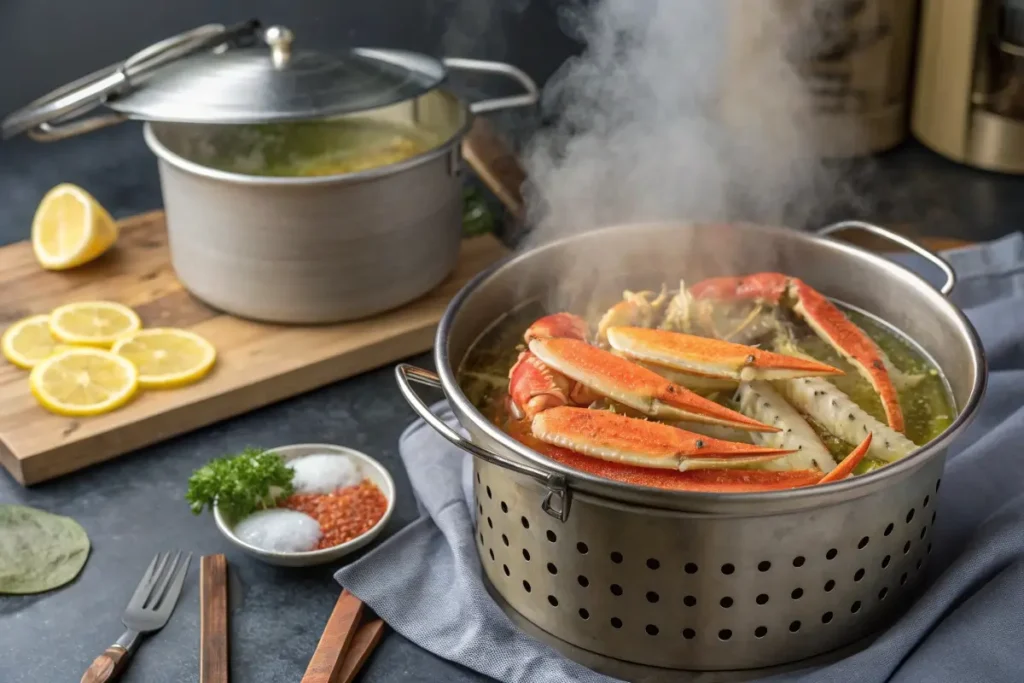
Preparing snow crab legs at home is easier than you might think. The most common methods include steaming, boiling, and baking. Each method results in slightly different textures and flavors, so experimenting to find your favorite is highly encouraged. Steaming is ideal for retaining moisture, while boiling can be faster but might dilute the crab’s flavor. Baking is a less common approach but can deliver a more robust, concentrated taste. Whichever method you choose, simplicity is often best when dealing with such high-quality seafood.
Steaming Snow Crab Legs: A Step-by-Step Guide
Steaming is a gentle method that preserves the delicate flavor and moisture of snow crab legs, and it’s also one of the easiest ways to cook them. This method is excellent for ensuring your crab legs stay succulent.
- Step 1: Fill a large pot with about two inches of water. You can add a bay leaf or a few slices of lemon for extra flavor.
- Step 2: Place a steamer basket or insert into the pot, ensuring that the water does not touch the bottom of the basket.
- Step 3: Carefully place the snow crab legs into the steamer basket, arranging them so they are not overcrowded.
- Step 4: Cover the pot and bring the water to a boil over medium-high heat.
- Step 5: Once boiling, reduce the heat to medium and steam for 5-7 minutes for thawed legs, or 8-10 minutes for frozen legs. The legs are done when they are heated through and the meat is opaque.
- Step 6: Remove the legs from the pot and serve immediately with your favorite dipping sauces, like melted butter or lemon wedges.
Boiling Snow Crab Legs: A Quick and Easy Approach
Boiling is a straightforward method to quickly prepare snow crab legs, especially useful when time is of the essence.
- Step 1: Bring a large pot of salted water to a rolling boil. Adding salt is crucial because the salt will penetrate the crab legs to season the meat and prevent the flavors from becoming bland.
- Step 2: Carefully place the snow crab legs into the boiling water, making sure that the pot is not overcrowded, because the water will become cooler, and therefore, it will be cooked improperly.
- Step 3: Reduce the heat slightly to maintain a gentle boil and cook for about 5-6 minutes for thawed legs and about 7-8 minutes for frozen legs. Make sure to stir gently occasionally, being careful not to splash yourself, and allow the crab legs to fully heat through.
- Step 4: Remove the crab legs and drain them.
- Step 5: Serve with melted butter, garlic butter sauce, or your choice of seasonings.
Baking Snow Crab Legs: Are snow crab legs flavorful?
Baking snow crab legs can create a slightly different texture and flavor profile, perfect for those looking for something a bit different.
- Step 1: Preheat your oven to 350°F (175°C).
- Step 2: Lightly coat the snow crab legs with olive oil or melted butter, ensuring to coat all the surface. You can also sprinkle garlic powder, paprika, or your favorite herbs for extra flavor.
- Step 3: Arrange the crab legs on a baking sheet, and ensure they are not overcrowded so they can cook evenly.
- Step 4: Bake for 10-12 minutes for thawed legs, or 15-20 minutes for frozen legs, or until they are heated through.
- Step 5: Remove from the oven and serve immediately. A squeeze of lemon juice will add a zesty finish.
Creative Serving Ideas for Snow Crab Legs
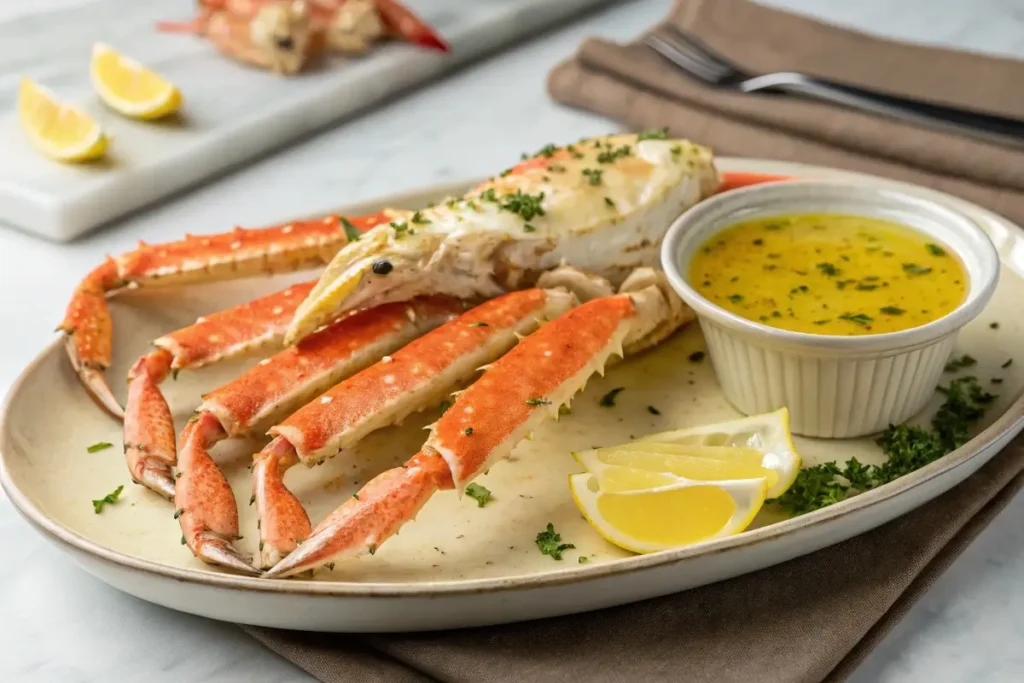
Snow crab legs are incredibly versatile and can be enjoyed in many different ways. One popular option is to simply serve them with melted butter, a classic combination that never disappoints. Adding fresh garlic and herbs to your melted butter can add a delightful twist. Snow crab legs are also excellent when incorporated into pasta dishes, salads, or seafood stews. For a spicy kick, consider serving them with a Cajun-inspired dipping sauce. The possibilities are endless when you embrace the versatility of snow crab legs.
How to Eat Snow Crab Legs Like a Pro
Eating snow crab legs might seem intimidating at first, but it’s quite simple once you get the hang of it. The most common tools include seafood crackers or kitchen shears to help crack open the shell. Begin by breaking the legs at the joints. Then, carefully peel back the shell to access the succulent meat inside. Use a small fork or your fingers to extract the meat, and dip into your favorite sauce. Don’t be afraid to get your hands a little messy; that’s part of the fun of enjoying snow crab legs. Embrace the process and enjoy every bite of your delicious seafood.
A Classic Snow Crab Legs Recipe with Garlic Butter Sauce
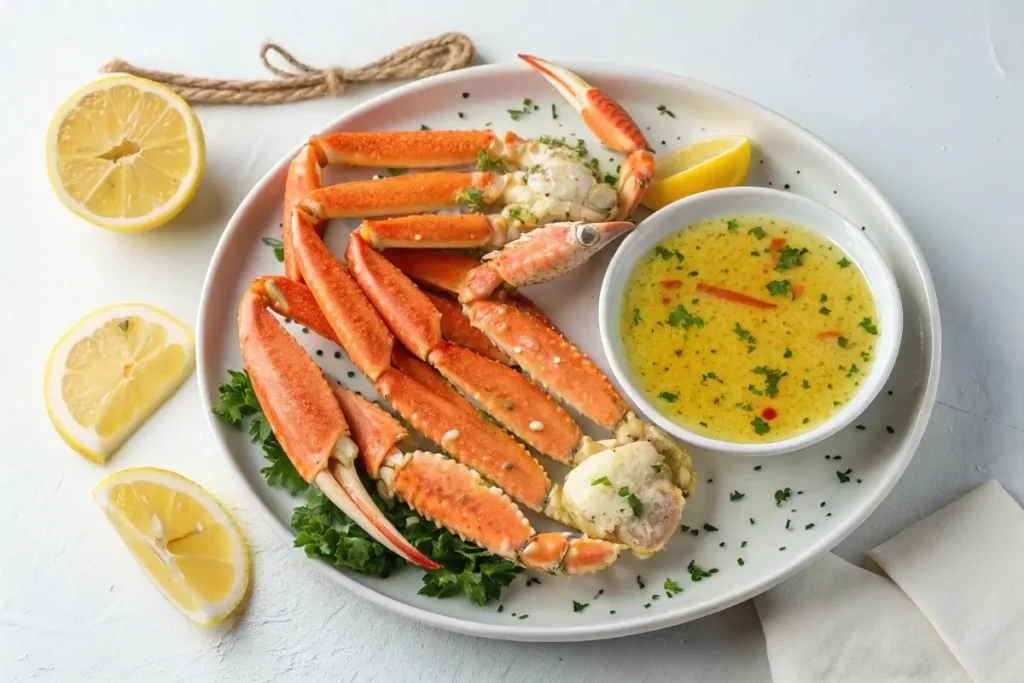
Is snow crab sweet ? This classic recipe combines the sweet taste of snow crab legs with a rich and savory garlic butter sauce. It’s perfect for a special occasion or a simple weeknight treat.
Yields: 4 servings
Prep time: 10 minutes
Cook time: 10-15 minutes
Total time: 20-25 minutes
Type of dish: Main Course
Cuisine: American
Ingredients:
- 2 lbs snow crab legs, thawed or frozen
- ½ cup (1 stick) unsalted butter
- 4 cloves garlic, minced
- 2 tablespoons lemon juice, fresh
- 1 tablespoon fresh parsley, chopped
- ½ teaspoon salt
- ¼ teaspoon black pepper
- Lemon wedges, for serving
Instructions:
- Prepare the Snow Crab Legs: Using your preferred method, steam, boil, or bake the snow crab legs according to the methods described above.
- Melt the butter in a small saucepan over low heat.
- Add the minced garlic and cook for about 1 minute until fragrant. Avoid burning it.
- Stir in the fresh lemon juice, chopped parsley, salt, and black pepper.
- Remove from the heat and keep warm.
- Arrange the cooked snow crab legs on a serving platter.
- Drizzle the garlic butter sauce over the crab legs, and serve immediately with lemon wedges. Enjoy while warm.
Snow Crab Legs: Are They Worth the Hype?
Absolutely! The answer to the question, “Are snow crab legs good?” is a resounding YES for countless reasons. From their delicate, sweet flavor to their nutritional benefits and ease of preparation, they are an amazing seafood option. Whether you’re a seasoned seafood lover or a curious beginner, snow crab legs offer a culinary experience that is sure to satisfy. Don’t hesitate to add them to your next meal plan and see for yourself what makes them so special. They’re not just a meal; they’re an experience that is well worth savoring and enjoying.
Why are snow crab legs such a fan favorite?
Snow crab legs are not just popular for their flavor but also because they offer a unique eating experience. The process of cracking the shells and extracting the meat is interactive and fun. This engagement with the food makes them perfect for gatherings and special occasions. The relatively affordable price compared to other types of crab also makes them accessible for more people to enjoy. It’s the combination of great taste, fun interaction, and reasonable price that makes snow crab legs a favorite for many.
A Funny Note About Snow Crab Legs
Why did the snow crab blush? Because it saw the ocean’s bottom!
Conclusion: Are Snow Crab Legs Good?
So, Are Snow Crab Legs Good? Absolutely! Their sweet flavor, nutritional value, and versatility make them a culinary delight that is well worth experiencing. Whether you’re preparing them for a casual meal or a special occasion, they’re sure to impress. Don’t hesitate to try them yourself and see why so many people love these amazing ocean treasures. Enjoy the experience and the wonderful flavors that snow crab legs have to offer!
FAQs
To eat snow crab legs, start by breaking them at the joints. Use seafood crackers or shears to crack the shell. Peel back the shell to expose the meat. Use a small fork or your fingers to extract the meat and dip it in your favorite sauce like melted butter or garlic butter.
Yes, you can bake snow crab legs. Preheat your oven to 350°F (175°C), lightly coat the legs with olive oil or butter and add seasonings. Bake for 10-12 minutes for thawed legs, or 15-20 minutes if frozen, until heated through.
